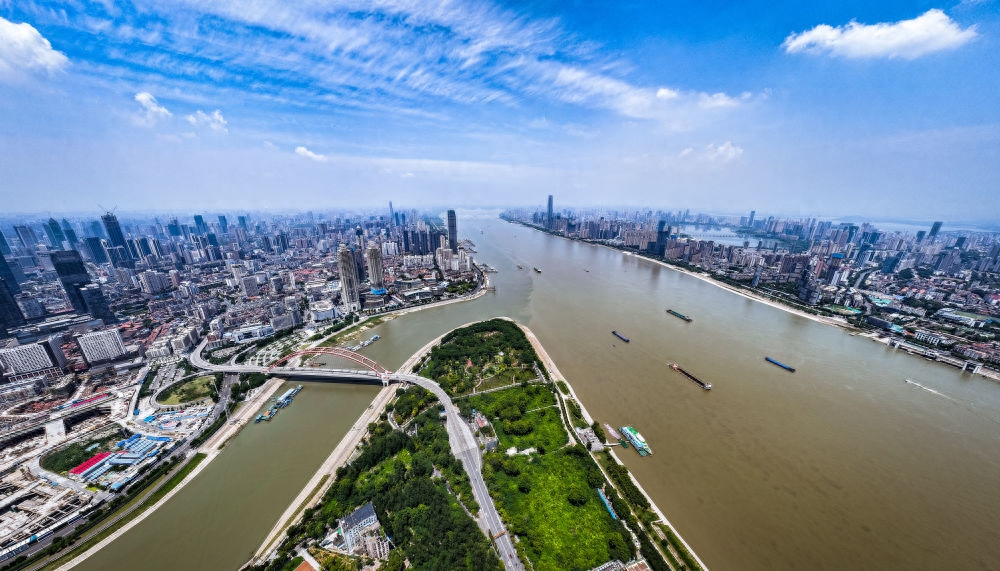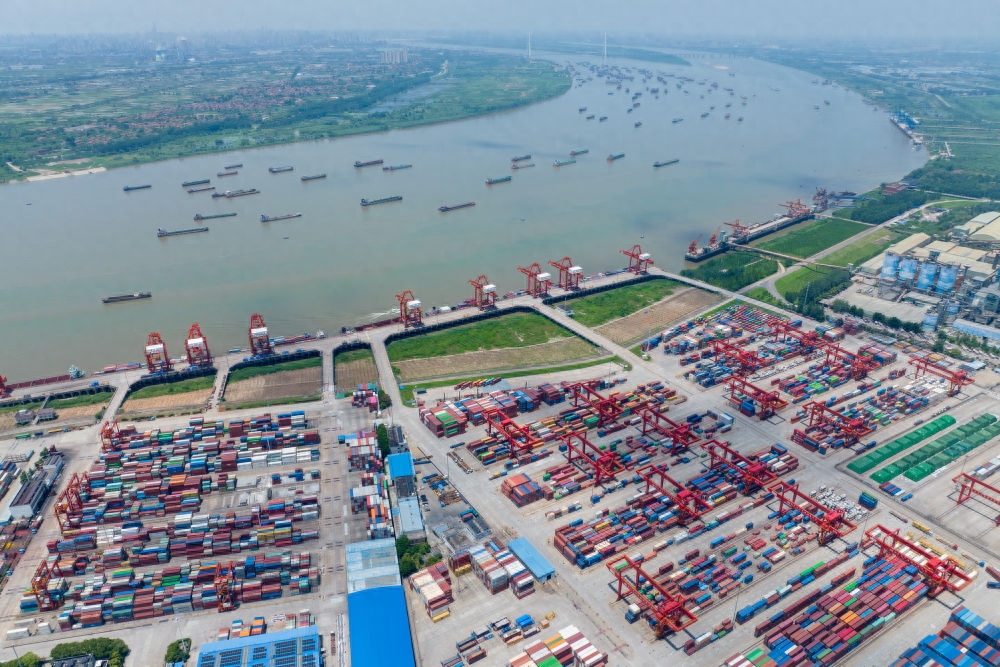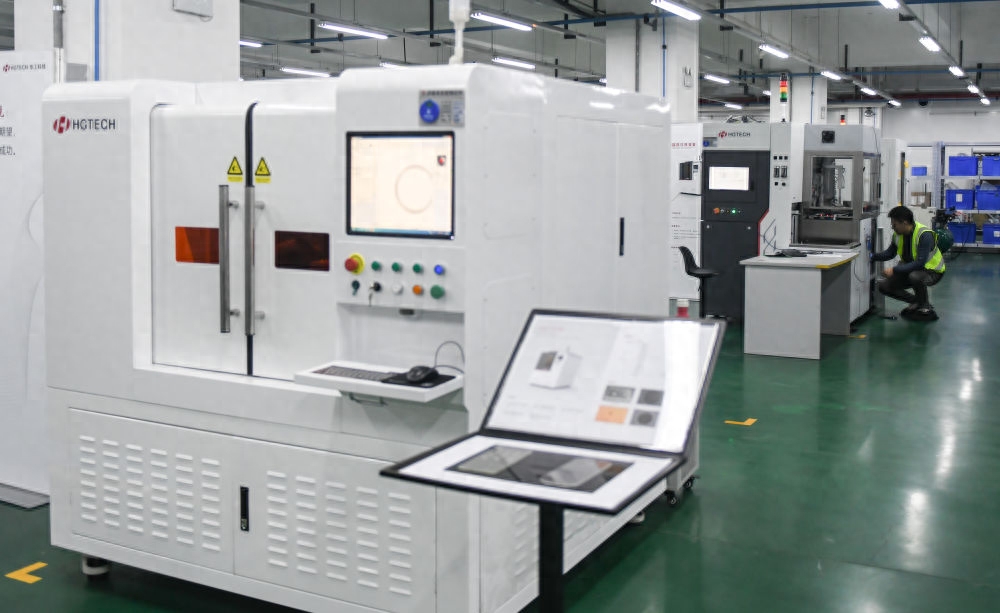
This is a city that thrives on water. The Yangtze River and the Han River meet here. The geographical advantages of reaching all directions and the open and inclusive humanistic character make "goods arrive in Hankou and live in Hankou" a striking symbol.
This is a city that strives for new things. Developed China's first optical fiber and established the country's first technology market... The spirit of "dare to be the first in the world" permeates urban development.
This is a "new city of the future" with unlimited potential. From the City of Hundreds of Lakes to the City of Wetlands, the picture of "harmony between man and nature" can be seen everywhere, and ecological endowments are increasingly transformed into new advantages for green rise.
Stand on the trend and cultivate business opportunities
During the white dew season, the autumn mood in Wuhan, Jiangcheng, is getting stronger. In front of the Longwang Temple Park, which was once a dangerous place for flood control, the Han River, the largest tributary of the Yangtze River, rushes from the Qinba Mountains for nearly 1,600 kilometers, then exits the northern foot of Guishan Mountain and intersects with the Yangtze River.

Two rivers and four banks of Wuhan City taken on June 14 (drone stitched photos). Photo by Xinhua News Agency reporter Wu Zhizun
Wuhan, which thrives on water and is famous for its business, has always been able to stand out and lead the trend at important historical junctures——
In the late 1970s, the wave of reform and opening up surged. At the intersection of the two rivers, 103 young people held certificates on Hanzheng Street and became the first batch of self-employed people in the country. Their timid shouts and shouts became a vivid scene of the reform of my country's commodity circulation system.
In just a few years, Hanzheng Street's products have spread to more than 20 provinces across the country, and its commodity transaction volume has ranked first in the country for many years.
"One penny for a needle can sell 100 million needles a year; a dime for a flint can sell 2 tons a year. The accumulated unsalable goods can be put into use once you have them." 83-year-old Zheng Juxuan He never imagined that he, who had weak eyesight since childhood, would one day sit in the Great Hall of the People and receive the commendation of "Pioneer of Reform".
Zheng Juxuan’s legendary experience is enough to give a glimpse of the city’s temperament and enterprising spirit.
Nowadays, when entering the Yunshang·Wuhan International Fashion Center located on Hanzheng Street, the voices of anchors "bringing goods" can be heard one after another. In just one office building, there are nearly 400 enterprises and merchants from the upstream and downstream of the live broadcast industry ecology, and the live broadcast room area exceeds 20,000 square meters.
From offline to online, from "buying nationwide and selling nationwide" to "buying globally and selling globally", Hanzheng Street, synonymous with "small commodity wholesale market", is no longer in the past, but "the entrepreneurial spirit of hard work and the innovative spirit of daring to be the first" "The business spirit of being good at seizing opportunities" has always been continued in Wuhan.
Dare to venture and fight, and also dare to overcome difficulties——
The COVID-19 epidemic hit. In the severe fight against the epidemic, the people of Wuhan understood the overall situation and took the overall situation into consideration. They were not afraid of hardships and dangers, were tenacious and unyielding, consciously obeyed the overall needs of epidemic prevention and control, and actively participated in the fight against the epidemic. They made significant contributions and made the whole country The whole world has seen the perseverance and integrity of the people of Wuhan.
After restarting amid difficulties and recovering from pain, from "pause" to "restart", Wuhan, the heroic city, made every effort to promote economic and social development, return to the "main track" and achieve "acceleration". In the first half of 2023, Wuhan's regional GDP was 950.333 billion yuan, an increase of 5% over the same period last year.
"Nine schools of thought flow through China, and a thread runs through the north and the south." Fu Caiwu, director of the National Institute of Cultural Development at Wuhan University, said that geographical space profoundly affects the cultural and psychological structure of regional society, shaping Wuhan's ability to adapt, let go, and innovate. And a comprehensive urban character.

In the early morning of January 7, the EMU was parked on the storage line of the Wuhan EMU section for maintenance and insulation operations (photo splicing by drone). Photo by Xinhua News Agency reporter Wu Zhizun
With the location advantage of being a central location on the outside and an open and inclusive cultural heritage on the inside, Wuhan is accelerating the construction of a "hub and link city" with the attitude of leaping forward, the ambition to tackle difficulties, and the responsibility to shoulder the responsibility.
In 2022, the throughput of Wuhan Yangluo Port, the largest inland river port, has reached 2.02 million TEU, with an average annual growth rate of 10%; in May this year, the 10,000-ton seagoing ship "Changyue 1" entered Wuhan for the first time since it opened to the outside world from South Korea. The Port of Busan arrived in Wuhan; in June, the 2023 World Transport Conference opened in Wuhan. As the only approved provincial capital city in the country to build a transportation powerhouse, Wuhan once again stood on the world stage...

The Phase I Terminal of Wuhan Yangluo Port taken on July 5 (drone photo). Photo by Xinhua News Agency reporter Wu Zhizun
"Jiang and Han come here from the west, and Chao Zong goes east without distinction." Today, Wuhan is accelerating from the "back team" of coastal opening up to the "front team" of inland development in the new era.
"In the past, sages rectified the world, and many creations started from Jianghan; today's transportation and railways can reach Asia and Europe without realizing they are far away." Zhang Zhidong's unfulfilled wish in the Qing Dynasty has become a reality a hundred years later.

The World Transport Conference opens in Wuhan (photo taken on June 14). Photo by Xinhua News Agency reporter Cheng Min
Strive forward to build a new city
"To plan for the future of Wuhan, we must set a scale that is slightly larger than New York or London." More than a hundred years ago, Mr. Sun Yat-sen drew up a blueprint for Wuhan in "The Strategy for the Founding of the People's Republic of China."
Wuhan, with a history of 3,500 years, has always had the dream of becoming a "big city". At the beginning of the 20th century, Hankou's merchandise trade volume once exceeded that of Tianjin and ranked second to Shanghai, becoming China's second largest foreign trade port and one of the four major financial centers.
"Driving beyond Tianjin and catching up with Shanghai" has become Jiangcheng's "highlight" moment; the praise of "Oriental Chicago" highlights Wuhan's past prosperity.
What supports the prosperity of the city is the Wuhan people’s ambition to “dare to be the first in the world” and their unremitting pursuit of innovation, change and progress.
From the ancestors of the Chu State who "made blue roads to open up mountains and forests", to Zhang Zhidong in the late Qing Dynasty who vigorously promoted "building new schools"; from the gunfire at the top of Wuchang City that kicked off the Revolution of 1911, to the invitation of the first leader of New China after the reform and opening up A "foreign factory director"; from encouraging "Saturday Engineers" to establishing the country's first technology market... the spirit of advancement and innovation of "new every day, new every day, new every day" has permeated the development process of the city.
Innovate and strive to be the first, forge ahead with perseverance, and stimulate surging momentum——
The first set of domestically produced CNC laser cutting machines, the first high-performance fiber laser, the first semiconductor laser chip... coming to Huagong Technology Industry Co., Ltd., each of them is "China's first" and is eye-catching.

Employees of Wuhan Huagong Laser Engineering Co., Ltd. work in the production workshop (photographed on March 17). Photo by Xinhua News Agency reporter Cheng Min
As one of the representative enterprises in Wuhan Optics Valley's optoelectronic information industry, Huagong Technology took the lead in formulating the first international standard for China's laser industry, won 3 National Science and Technology Progress Awards, and has developed in the fields of high-end optical chips, high-performance optical fibers, ultrafast lasers, etc. A breakthrough in core technology has been achieved, and it has grown from a school-run enterprise with an annual turnover of less than 80 million yuan to an enterprise with a revenue of tens of billions.
"Currently, Huagong Technology is carrying out collaborative innovation around new infrastructure, new materials, new energy, the new four modernizations of automobiles, and industrial digital intelligence, enriching the product chain, improving the industrial chain, and deeply expanding the high-end market." said Ma Xinqiang, chairman of Huagong Technology.
Spread out the city map of Wuhan, Optics Valley, where Huagong Technology is located, was once called "the forgotten two centimeters on the map of Wuhan" many years ago.

Wuhan Optics Valley Plaza complex taken on June 14 (drone photo). Photo by Xinhua News Agency reporter Wu Zhizun
From the suburbs of the city to the "World Optics Valley", the road to self-reliance and self-improvement through science and technology illuminated by "a beam of light".
In 1976, China's first quartz optical fiber was born in a simple laboratory next to the Wuhan Institute of Posts and Telecommunications. Relying on independent innovation, my country's optical fiber communication technology and industrial development have achieved zero breakthroughs.
Pursue "light" and build dreams with "light", Wuhan City focuses on the optoelectronic information industry to promote the construction of the Optics Valley, driving the rapid development of related enterprises and clustering into chains.
Optics Valley has gradually become one of the first batch of national high-tech zones, been approved as a national optoelectronic information industry base, and has become the world's largest optical fiber and cable research and development base, China's largest optical device R&D and production base, small and medium-sized display panel base, and China's largest One of the laser industry bases.
As of 2022, the total annual revenue of Optics Valley’s optoelectronic information industry cluster will exceed 500 billion yuan. The "city of science" and "city chasing light" are increasingly becoming "city of longing".
Optics Valley is the epitome of Wuhan’s determination to innovate and its courage to make breakthroughs.
Looking at Jiangcheng, Wuhan Economic Development Zone has gathered 9 complete vehicle companies, 13 complete vehicle factories and more than 500 well-known parts and components companies, with an annual output of one million complete vehicles and an industrial output value of over 320 billion yuan. It is making every effort to build "China's automobile industry". valley";

At the Lotus Global Smart Factory located in Wuhan Economic and Technological Development Zone, workers work on the assembly line (photographed on June 19). Photo by Xinhua News Agency reporter Cheng Min
Wuhan Dongxihu District is taking the construction of a national network security talent and innovation base as an opportunity to build an influential "China Internet Valley" with high standards...
Statistics from the Wuhan Municipal Science and Technology Bureau show that in 2022, the added value of Wuhan's high-tech industries above designated size will be 524.54 billion yuan, accounting for 44.84% of Hubei Province.
The sails are sailing vigorously, the wind is strong, and the courage to stand on the tide is full of new things. Looking to the future, Wuhan’s prospects are promising——
As the intersection of two national strategies, the development of the Yangtze River Economic Belt and the rise of the central region, Wuhan, which has 90 universities and nearly 1.3 million college students, has built 149 national-level innovation platforms, with a total of 3.0429 million talents of all types, and has won Approved to build “a scientific and technological innovation center with national influence”.
Wuhan Mayor Cheng Yongwen said that in 2023, Wuhan has set new goals: the number of high-tech enterprises will exceed 13,000, and the added value of high-tech industries will increase by more than 11.5%...
A new chapter in green rise
The Yangtze River and the Han River pass through the city. There are 166 lakes and 277 reservoirs dotted throughout the city. The total water area accounts for about a quarter of the city's land area. The per capita water resources are about 40 times the national average...
Wuhan thrives on water, but has also been trapped by water.
"The wild trees cover the wild geese, and the fishing boats reflect the flying crows." In the words of Song Dynasty poet Yuan Suoyou, the East Lake more than 800 years ago was elegant and lively. But more than ten years ago, the water quality of East Lake was rapidly deteriorating due to industrialization and urbanization, which kept Ke Zhiqiang, the first "private lake director" of East Lake, awake at night.
Entering the new century, the clarion call for water environment management in Wuhan has sounded. External source interception and control, internal source cleanup, water system connection, ecological restoration, smart supervision...a battle to control lake pollution has begun.
"Today, the water quality of East Lake has stably entered the 'Class III era.'" Ke Zhiqiang said, with a water area of more than 33 square kilometers, East Lake has recreated the spectacular scene of "sixty miles of smoke and waves".

Wuhan East Lake taken on July 23 (drone photo). Photo by Xinhua News Agency reporter Wu Zhizun
There are 10 large lakes, more than 120 islands, and nearly 20,000 acres of lush mountain forests... Cycling along the East Lake Greenway, the scenery is different in four seasons. Bookstores, art galleries and other urban public spaces scattered throughout the city add rich humanistic sentiments and romantic artistic atmosphere.
"The mountains and rivers are interdependent, the city and the lake are integrated, and the humanities complement each other. This place is becoming the 'poetry and distance' in the hearts of more tourists." said Liu Haotang, secretary of the East Lake Eco-tourism Scenic Area Working Committee and director of the Management Committee.
During this year’s May Day holiday, Wuhan ranked among the top ten popular tourist cities in the country. The Yangtze River Bridge, Lingbo Gate, River Beach...a series of water-friendly platforms have become popular attractions. They can enjoy the river breeze and enjoy the lake view. People can climb up here to look into the distance, step down to enjoy the water, and feel the charm of the river city where people and water coexist.

The Yellow Crane Tower in Wuhan taken on June 14 (drone stitched photos). Photo by Xinhua News Agency reporter Wu Zhizun
There are nine clouds in the sky, connected by rivers and lakes. With the improvement of the ecological environment, the reshaping of urban geographical space around a pool of clear water has quietly begun.
In February this year, the "Wuhan New City Plan" was officially released, and a new city aimed at "a world-class source of scientific and technological innovation and a model of a Chinese-style modern livable wetland city" is about to emerge.
This new city breaks away from traditional administrative divisions and spans Wuhan and Ezhou. It has a planned area of about 1,689 square kilometers. The key project library currently has 205 projects exceeding 100 million yuan, with a total investment of 437.644 billion yuan, including Liangzi Lake, Yanxi Lake, etc. It is surrounded by lakes and wetlands.
"Beautiful scenery is also a beautiful economy, and important innovation areas in the world often have the element of water." Zhao Shouliang, a professor at the School of Architecture and Urban Planning at Huazhong University of Science and Technology, said that the landscape pattern provides a foundation for the town's characteristic style, and the rich public spaces can better gather people together. Innovative talents.
From "conflicts between people and water, confrontation between cities and rivers" to "people and water are dependent on each other and grow towards the water", from "enjoyed work drives safe housing" to "settled housing leads to happy work", behind the transformation of urban development logic is the comprehensive development concept progress.
"The wine is pouring, and the mood is rising." Facing the future, Wuhan is writing a new chapter in the integrated development of humanities, science and technology, ecology and economy with vitality and vitality.
Text reporters: Hui Xiaoyong, Li Pengxiang, Liang Jianqiang, Xiong Qi
Video reporters: Yu Guoqing, Fang Yadong, Yang Muqian, Xiong Qi
Poster design: Pan Hongyu
Editors: Chu Xinghua, Lei Min, Liu Lianfen, Hu Bixia, Hou Bangxing
Coordinator: Zhou Yongmin, Gao Xinxin
Articles are uploaded by users and are for non-commercial browsing only. Posted by: Lomu, please indicate the source: https://www.daogebangong.com/en/articles/detail/ji-mu-jiang-cheng-wan-xiang-xin-ren-wen-jing-ji-shi-ye-xia-de-wu-han-guan-cha.html

 支付宝扫一扫
支付宝扫一扫 
评论列表(196条)
测试